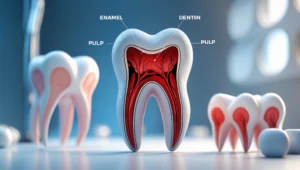Dental fillings are essential in oral health for keeping our teeth healthy and strong. These tiny restorations are not just about plugging a hole; they are the unsung heroes that prevent further decay and safeguard our smiles. Let’s delve into the essential role dental fillings in Pines play in maintaining oral health and preventing the progression of decay.
Understanding Dental Cavities
How Cavities Develop
Cavities, those sneaky underminers of oral health, develop when the enamel—the protective outer layer of our teeth—succumbs to decay. This decay is primarily caused by the acids produced by plaque, the sticky film of bacteria that forms on our teeth.
Impact of Plaque and Bacteria on Tooth Enamel
Plaque and bacteria create a hostile environment in our mouths. The acids they produce gradually erode enamel, creating a breeding ground for cavities. Understanding this process is crucial in recognizing the signs that a dental filling may be needed.
Common Signs of Tooth Decay
Tooth Sensitivity
- Sensitivity occurs when tooth enamel is compromised, exposing the nerves.
- Hot or cold substances trigger sharp, uncomfortable sensations.
How Sensitivity May Indicate Enamel Erosion
- Enamel erosion exposes dentin, a softer layer beneath, leading to sensitivity.
- Feeling sensitivity may indicate the early stages of tooth decay.
Recognizing the Difference Between Temporary and Persistent Pain
- Temporary pain may result from stimuli like hot/cold and usually subsides.
- Persistent pain, especially when not provoked, may indicate a deeper issue.
How Continuous Pain May Signal a Cavity
- A lingering toothache can signify decay reaching the tooth’s nerve.
- Seeking professional evaluation is crucial for an accurate diagnosis.
Visible Holes or Pits in Teeth
- Cavities may manifest as visible holes or pits on tooth surfaces.
- Regular self-examinations enable early detection.
Importance of Regular Self-Examinations
- Routine checks at home empower individuals to spot potential issues early.
- Prompt identification of cavities aids in timely intervention.
Discoloration or Stains
- Discoloration, such as white spots or brown stains, may indicate decay.
- Different types of discoloration carry varied implications.
Types of Discoloration and Their Implications
- White spots may suggest early enamel demineralization.
- Brown stains may indicate more advanced decay.
Signs You Need a Dental Filling
Sharp Pain When Biting or Chewing
- Pain while biting or chewing could indicate a cavity affecting the tooth’s structure.
- Professional evaluation is essential to determine the cause.
Seeking Professional Evaluation for Pain During Biting
- Dentists can conduct thorough examinations, including X-rays, to diagnose issues.
- Early identification enables prompt treatment, often with a dental filling.
Recognizing the Significance of Dark Spots or Visible Holes
- Dark spots or visible holes may signal advanced decay.
- Prompt consultation with a dentist near you is crucial for an accurate diagnosis.
Addressing Concerns with a Dentist for Proper Diagnosis
- Dentists can assess the extent of decay and recommend appropriate treatments.
- Early intervention can prevent further deterioration.
Increased Sensitivity to Sweets
- Sugary foods can trigger sensitivity in decayed teeth.
- Discussing changes in sensitivity with a dentist in Pines.
Importance of Discussing Changes in Sensitivity with a Dentist
- Dentists can evaluate the cause of increased sensitivity and recommend suitable interventions.
- Open communication ensures comprehensive oral care.
Importance of Timely Intervention
Preventing the Progression of Decay
- Timely intervention with dental fillings prevents decay from advancing.
- Addressing cavities early minimizes the risk of complications.
Avoiding Complications That May Lead to More Extensive Treatments
- Early detection and treatment with dental fillings help avoid more invasive procedures.
- Timely care preserves tooth structure and minimizes the need for extensive interventions.
Dental Filling Procedure
Overview of the Dental Filling Process
- Dental fillings involve removing decayed material and restoring the tooth with a filling material.
- Usually, the process is simple and can be accomplished in one appointment.
Different Types of Dental Fillings and Their Considerations
- Various filling materials, such as amalgam, composite, and ceramic, cater to different needs.
- Dentists consider factors like durability, aesthetics, and cost when recommending a filling type.
Preventive Measures
Importance of Regular Dental Check-ups
- Routine dental check-ups facilitate early detection of cavities.
- Regular professional cleanings help prevent the formation of new cavities.
Adopting Good Oral Hygiene Practices to Prevent Cavities
- Consistent brushing and flossing remove plaque, reducing the risk of cavities.
- A fluoride toothpaste strengthens enamel, contributing to cavity prevention.
Conclusion
Recap of Key Signs Indicating the Need for a Dental Filling:
- From tooth sensitivity to visible holes, recognizing signs of decay is crucial.
- Prompt action, often in the form of a dental filling, is key to preserving oral health.
Emphasizing the Role of Early Detection in Maintaining Oral Health:
- Early detection of cavities ensures timely intervention.
- Dental fillings, when indicated, play a vital role in preventing further decay and preserving our smiles.
- For those in Pines, prioritizing oral health, including regular check-ups and addressing signs of decay promptly, contributes to a lasting, confident smile. Keep in mind that acting promptly can prevent further complications, and in dentistry, getting dental fillings on time can preserve your teeth.






